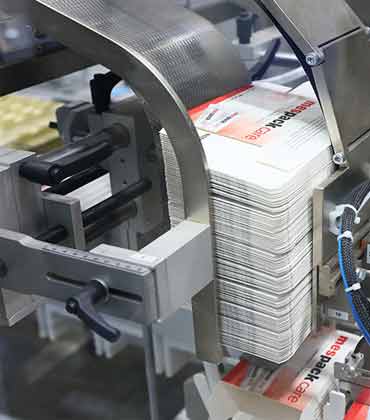THANK YOU FOR SUBSCRIBING
By Arun Ahuja, Senior Vice President & General Manager, Healthcare & Corporate at Transact + CBORD
The Path of Least Resistance: Connecting Hospital Food...
By Jenica Eisenbach, PPG Global Technical Service Director, Packaging Coatings
What's ahead for beverage and food can manufacturing?
By Benjamin Kant, Assistant General Manager and Operations Manager, Bowery Farming
Automation in the Indoor Farming Space

Looking Ahead to 2024 for Italian Wines in the US
Ciro Pirone, Director of Italian Wines at Horizon Beverage

 Ciro Pirone, Director of Italian Wines at Horizon Beverage
Ciro Pirone, Director of Italian Wines at Horizon BeverageLooking back at 2023, data told us that globally wine consumption and sales have shrunk. Some of the causes that are effecting wine sales are: new generations drinking a variety of other beverages like craft beers, RTDs and mixed drinks, wine being seeing more as an “older” generation beverage and to be mostly consumed over dinner; over-production globally, price increases, and possibly another challenge could be that wine is a product where more “homework” is necessary before feeling comfortable before purchasing a bottle.
Data from the Oemv (Observatorio Espanol del Mercado del Vino) at the end September 2023 and compared to the year prior showed that in the world there has been a loss of 768 million liters of wine and 802 million euros respectively. Price went up an average of 18 cents, which does not sound like much when looked at it this way but this is a global statistic.
Only two of the top 11 producing countries, New Zealand and Portugal were able to grow in volume respectively 9.7% and 0.4%.
While France remained in first place for revenues with 12.1 billion euros they still had a loss of 87.7 million liters, Italy in second place with 7.7 billion euros in revenue also lost 58.6 million liters. However, these two countries did not have it as bad as others being two of the three most significant wine producers in the world (Spain being second, behind Italy and in front of France), and together with that price increases helped balance the overall losses of business/sales.
The US wine industry registered the most significant increases and at the same time double digit losses (-11% as of November 2023 that changed a bit by year’s end) as a result of the tough competition in the marketplace by so many other products and probably also the general tiredness towards the bigger, richer, quite alcoholic and at times mono-dimensional wines (big volume wines).
Within this down spiral in the US market, Italy has been able to maintain a reasonably strong positioning (doing better than most imported wines) although still with negative 3% (as of November 2023); this negative number was helped by the growing sales of Italian sparklers (Prosecco first and foremost).
Interestingly enough sparkling Italian wines are now the most significant slice of the pie with a 38% share versus white wines following at 35.5% and lastly and probably quite a bit unexpectedly red wines close at 17.5%.
With such a turbulent landscape, what can a massive wine producing and exporting country like Italy do to get back on the positive sign? These are questions that all wine organizations, producers, consortiums, governmental and trade agencies as well as all of us in the Italian wine business ask ourselves all the time and especially en lieu of a 2024 to say the least challenging ahead of us.
In my opinion, Italy with its amazing overall bio-diversity but more specifically grape varietals truly endless and second to none diversity can come out strong and continue to be the top player as far as imports in the US and build a lot of interest within new generation and not-so-experienced wine consumers.
Maybe the “concept” of the Italian dolce vita that many Americans love and get to enjoy while traveling to Italy, maybe the huge amount of regional cooking preparations and healthy Mediterranean diet that translate into so many dishes found in so many restaurants throughout the country, sustainability all around that has been a big subject for many years for growers and producers, incredible territories with amazing winemaking traditions but also newer generations of winemakers approaching the scene and understanding that Italian wines have to have approachability and balance between tannins, fruit, alcohol, acidity and sense of place, despite of Sagrantino di Montefalco being a tannic powerhouse, Nebbiolo being the king of gastronomic wines and Primitivo di Manduria the juicy, jammy and quite alcoholic Southern Italian red wine.
I think as a wine producing country, Italy has to be capable to better tell its history and wine stories, united as Italian wine but at the same time fiercely independent and “campalinisti” as expected to be. Raising the quality bar and offering unique wines from sparkling like (the behemoth) Prosecco Doc and Docg but also Franciacorta, Trento Doc, Alta Langa, Lambruscos that are just succulent and dark but also pinkish and savory and laser like sharp and the many other gorgeous sparklers out there; to an amazing array of white wines with Pinot Grigio (like it or not) leading the way but also savory and briny Vermentinos, age-worthy Greco di Tufo and Fiano di Avellino, volcanic Etna biancos and Soaves to die for, but every region has its own grapes, flavors and tastes.
Reds have been the once suffering most maybe because more and more there is a trend towards less alcoholic wines and maybe also consuming wines more as aperitifs and in more casual settings without necessarily accompanying by full meals. Nonetheless I still personally believe there is a bright future for Italian reds beyond the established big boys (Chianti Classico, Brunello di Montalcino, Barolo, Montepulciano d’Abruzzo), many varietals can offer a fresh, vibrant, crunchy personality coupled with floral/berried fruits aromas and flavors with lower to medium alcohol levels, just imagine a Valpolicella Classico or Valle d’Aosta Fumin, Schiava from Lake Caldaro in Alto-Adige but also Rossese di Dolceacqua in Liguria’s westernmost part that is a perfect companion to fish soups, and going further down the boot a high elevation Sangiovese is a thing of beauty and balance, and worthy of mention the wines of Castel del Monte in Puglia’s higher reaches and finally Nerello Mascalese from Etna’s peaks with their savory, herbal and floral character.
Recently I read an article about the Valpolicella area where 67 million bottles of wine are produced, 14.2 million of which Amarone della Valpolicella (17% of the total production) that is a full, generous, fruit forward and higher alcohol wine byproduct of the appassimento (de-hydration) process of the grapes post-harvest. A wine historically heavily exported in Northern Europe, Canada and US which is facing its own challenges (connected to global warming) due to the wine’s opulent character and higher alcohol. Producers have been working on updating the production regulatory system (DOCG) for Amarone to possibly reduce the period of appassimento of the grapes so reducing the residual sugars (eventually turning into alcohol), reducing the current ageing requirement and selecting the proper vessel for ageing, appropriate trellising system and a proper zoning of the territory to define each valley, hill, vineyard. Lots of work ahead for the producers in the Valpolicella area to make a fresher, livelier and more drinkable Amarone.
Mine are only hopes based on such a colorful scenery of amazingly unique grape varietals and spectacularly unique territories scattered thru the countryside of Italy that hopefully will capture the taste buds and enjoyment for a taste of la dolce vita of many.
We don’t know what 2024 will ultimately bring but can only hope for a healthier wine world.
Read Also














